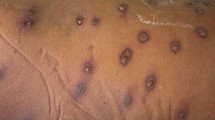Abstract
The medical records of patients admitted between 1985 and 2007 with wasp stings were retrospectively analyzed. Among the 45 children, seven developed acute renal failure. Classical clinical and laboratory data pointed to hemolysis and rhabdomyolysis as the underlying pathophysiology. All patients had hyponatremia and hyperkalemia as well as metabolic acidosis. Six patients had anemia. Five patients were oliguric for 9 to 15 days. Maximum serum creatinine was 4.0 to 11.9 mg/dl. Peritoneal dialysis was performed for 3 to 15 days. One patient died due to hyperkalemia, the remaining ones recovered completely. This paper wants to remind pediatricians to watch for acute renal failure in children with wasp stings.
Similar content being viewed by others
References
Bilo BM, Rueff F, Mosbech H et al (2005) Diagnosis of Hymenoptera venom allergy. Allergy 60:1339–1349
Chai PT, Quan TL, Lam TTN (2006) Acute renal failure due to hornet stings. Y Hoc TP Ho Chi Minh 10:376–380
Chao YW, Yang AH, Ng YY et al (2004) Acute interstitial nephritis and pigmented tubulopathy in a patient after wasp stings. Am J Kidney Dis 43:e15–19
Chugh KS, Sharma BK, Singhal PC (1976) Acute renal failure following hornet stings. J Trop Med Hyg 79:42–44
Daher EF, da Silva Junior GB, Bezerra GP et al (2003) Acute renal failure after massive honeybee stings. Rev Inst Med Trop Sao Paulo 45:45–50
Day JM (1962) Death due to cerebral infarction after wasp stings. Arch Neurol 7:184–186
D’Cruz S, Chauhan S, Singh R et al (2008) Wasp sting associated with type 1 renal tubular acidosis. Nephrol Dial Transplant 23:1754–1755
Franca FO, Benvenuti LA, Fan HW et al (1994) Severe and fatal mass attacks by ‘killer’ bees (Africanized honey bees—Apis mellifera scutellata) in Brazil: clinicopathological studies with measurement of serum venom concentrations. Q J Med 87:269–282
Humblet Y, Sonnet J, van Ypersele de SC (1982) Bee stings and acute tubular necrosis. Nephron 31:187–188
Mejia G, Arbelaez M, Henao JE et al (1986) Acute renal failure due to multiple stings by Africanized bees. Ann Intern Med 104:210–211
Monzon C, Miles J (1980) Hemolytic anemia following a wasp sting. J Pediatr 96:1039–1040
Munoz-Arizpe R, Valencia-Espinoza L, Velasquez-Jones L et al (1992) Africanized bee stings and pathogenesis of acute renal failure. Nephron 61:478
Nace L, Bauer P, Lelarge P et al (1992) Multiple European wasp stings and acute renal failure. Nephron 61:477
Sakhuja V, Bhalla A, Pereira BJ et al (1988) Acute renal failure following multiple hornet stings. Nephron 49:319–321
Sharmila RR, Chetan G, Narayanan P et al (2007) Multiple organ dysfunction syndrome following single wasp sting. Indian J Pediatr 74:1111–1112
Shilkin KB, Chen BT, Khoo OT (1972) Rhabdomyolysis caused by hornet venom. Br Med J 1:156–157
Sitprija V, Boonpucknavig V (1972) Renal failure and myonecrosis following wasp-stings. Lancet 1:749–750
Tan KH (1966) Fatal haemolysis from wasp and hornet sting. Singapore Med J 7:122–126
Thiruventhiran T, Goh BL, Leong CL et al (1999) Acute renal failure following multiple wasp stings. Nephrol Dial Transplant 14:214–217
Vachvanichsanong P, Dissaneewate P, Mitarnun W (1997) Non-fatal acute renal failure due to wasp stings in children. Pediatr Nephrol 11:734–736
Vikrant S, Pandey D, Machhan P et al (2005) Wasp envenomation-induced acute renal failure: a report of three cases. Nephrology (Carlton) 10:548–552
Weizman Z, Mussafi H, Ishay JS et al (1985) Multiple hornet stings with features of Reye’s syndrome. Gastroenterology 89:1407–1410
Zhang R, Meleg-Smith S, Batuman V (2001) Acute tubulointerstitial nephritis after wasp stings. Am J Kidney Dis 38:E33
All authors of this article declare they have no conflict of interest or financial relationship with any sponsoring organization.
Author information
Authors and Affiliations
Corresponding author
Rights and permissions
About this article
Cite this article
Vachvanichsanong, P., Dissaneewate, P. Acute renal failure following wasp sting in children. Eur J Pediatr 168, 991–994 (2009). https://doi.org/10.1007/s00431-008-0909-5
Received:
Accepted:
Published:
Issue Date:
DOI: https://doi.org/10.1007/s00431-008-0909-5




